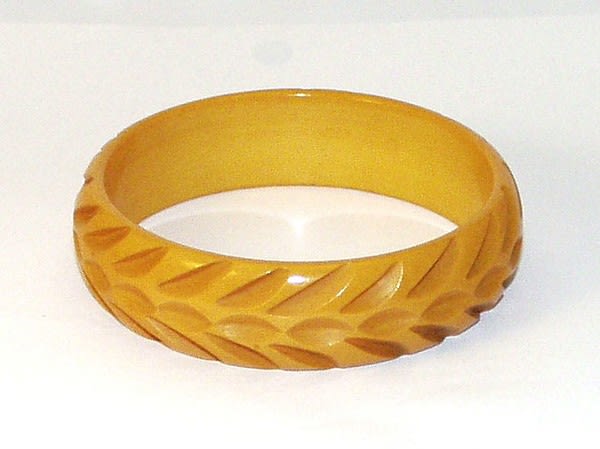Originally an industry invention that snuck its way into the jewelry scene, Bakelite has become synonymous with costume jewelry from the early 20th century. Just how did it make the jump? Read below for all the details, as well as info on how to tell fakes from the real deal.

Photo credit: Live Auctioneers
How old is it? According to Collectors Weekly, Bakelite is a plastic resin that was developed by Leo Baekeland in 1907 but it didn’t become a part of the fashion world until the 1920s. Because it could withstand a lot of heat, it became popular in the industrial world but that’s not exactly what made it such a hot commodity for jewelers. They liked how tough the material was solid for beads and bracelets, sturdy enough to carve and cut as well as all the colors it came in.
Why did it become popular? The jewelry itself was lightweight, durable, and easy to mold into different shapes but About speculates that the introduction of more Bakelite colors really made it boom in the 1930s and 1940s. The jewelry itself was also relatively inexpensive no surprise that people liked the affordability during that time period — and Plastics Make It Possible adds that vibrant patterns also had people flocking to buy it.

Photo credit: Art Fire
Is it tough to find? You probably recognize this theme not necessarily, but reproductions abound (cleverly called “Fakelite”). There are a lotof Bakelite jewelry fakes out there, and below we have some tests and tricks for deciphering the real thing from a reproduction. Finding the much-loved “Philadelphia bracelets” might be a little tougher, but kudos if you do they are very valuable!
How much does it cost? Generally, Bakelite jewelry sells for anywhere between $40 and $1,000 it all depends on the piece itself. On average, prices are frequently between $50 and $300, though older pieces (1920s to 1940s) and some bangles carry prices of $800 or more. Sought-after “Philadelphia bracelets” have gone at auction for more than $1,000.

Photo credit: Vintage Jewelry Online
What are some identifying features?
- Weight: Bakelite is lightweight, so anything heavy should raise a red flag.
- Carvings: Because Bakelite is so durable, it’s easy to carve into so don’t be surprised to find bangles and other jewelry pieces with designs carved into them.
- The 409 test: If you have a piece and aren’t sure if it’s authentic, put some 409 house cleaner on a cotton swab and dab a small spot on the jewelry (somewhere on the back or not usually visible). If the swab turns yellow, you’ve got vintage Bakelite, according to About. Make sure to rinse off the cleaner from the spot afterward.
- Smell: Oddly enough, this test could help if you find potential Bakelite jewelry to buy. An eBay user offers this tip rub a spot on the Bakelite to create some friction, and then smell. If the scent is like formaldehyde, then you’ve probably got real Bakelite.
- Mold marks and seams: The same eBay user cautions that Bakelite shouldn’t have any mold marks or seams, because real Bakelite was carved. Dual colored bangles will have that seam because there are separate colors, but a one-tone piece of jewelry shouldn’t have that if it’s real Bakelite.
- Hardware: Va-Voom Vintage offers this helpful tidbit hardware like pinbacks were generally not glued on, but riveted on or embedded into the Bakelite. Glue might be a sign that it’s a reproduction, or simply that it was repaired along the way and isn’t in original form anymore.
- Color: Bakelite has some distinct colors and swirly patterns, which become more obvious after you’ve been collecting for while. Check a reference guide if you’re not sure about a specific color.
SKM: below-content placeholderWhizzco for DOT

